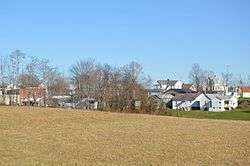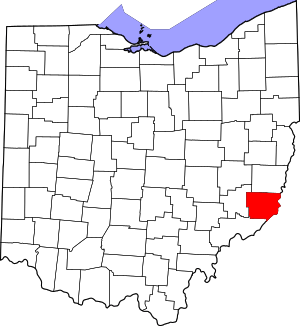Stafford, Ohio
Stafford is a village in Franklin Township, Monroe County, Ohio, United States. Originally named Bethel, the town was laid out by John Jones in 1838.[6] Stafford has a rich history as a station on the Underground Railroad. It was known as a "free black" settlement because of the number of African Americans living there, but its population included both black and white ardent abolitionists. It is said that almost everyone in the village was involved in the protection of slaves fleeing to freedom. The most frequented route ran from Marietta in Washington County, Ohio, through Stafford and on to Summerfield, Noble County, Ohio. These lines continued into Ontario, Canada.
Stafford, Ohio | |
|---|---|
 Methodist church, State Route 145 and Main Street | |
 Location of Stafford, Ohio | |
 Location of Stafford in Monroe County | |
| Coordinates: 39°42′48″N 81°16′39″W | |
| Country | United States |
| State | Ohio |
| County | Monroe |
| Township | Franklin |
| Area | |
| • Total | 0.34 sq mi (0.88 km2) |
| • Land | 0.34 sq mi (0.88 km2) |
| • Water | 0.00 sq mi (0.00 km2) |
| Elevation | 1,079 ft (329 m) |
| Population | |
| • Total | 81 |
| • Estimate (2019)[4] | 75 |
| • Density | 220.59/sq mi (85.22/km2) |
| Time zone | UTC-5 (Eastern (EST)) |
| • Summer (DST) | UTC-4 (EDT) |
| ZIP code | 43786 |
| Area code(s) | 740 |
| FIPS code | 39-74300[5] |
| GNIS feature ID | 1076954[2] |
William Steel, a Scottish-born abolitionist, is credited with changing the name of the village from Bethel to Stafford. He was the father of William Gladstone Steel. He is credited with establishing a good educational system that was also integrated.
The population was 81 at the 2010 census.[7]
Stafford is served by the Monroe County District Library from its administrative offices in Woodsfield, Ohio.
Stafford was the hometown of AIDS activist David Kirby whose life and death were featured in Life Magazine in the 1990s.
Geography
Stafford is located at 39°42′48″N 81°16′39″W (39.713226, -81.277435).[8]
According to the United States Census Bureau, the village has a total area of 0.34 square miles (0.88 km2), all of it land.[9]
Demographics

| Historical population | |||
|---|---|---|---|
| Census | Pop. | %± | |
| 1850 | 124 | — | |
| 1860 | 197 | 58.9% | |
| 1870 | 150 | −23.9% | |
| 1880 | 172 | 14.7% | |
| 1910 | 174 | — | |
| 1920 | 158 | −9.2% | |
| 1930 | 145 | −8.2% | |
| 1940 | 163 | 12.4% | |
| 1950 | 141 | −13.5% | |
| 1960 | 113 | −19.9% | |
| 1970 | 120 | 6.2% | |
| 1980 | 98 | −18.3% | |
| 1990 | 89 | −9.2% | |
| 2000 | 86 | −3.4% | |
| 2010 | 81 | −5.8% | |
| Est. 2019 | 75 | [4] | −7.4% |
| U.S. Decennial Census[10] | |||
2010 census
As of the census[3] of 2010, there were 81 people, 34 households, and 25 families residing in the village. The population density was 238.2 inhabitants per square mile (92.0/km2). There were 41 housing units at an average density of 120.6 per square mile (46.6/km2). The racial makeup of the village was 93.8% White, 4.9% African American, and 1.2% Native American.
There were 34 households, of which 20.6% had children under the age of 18 living with them, 64.7% were married couples living together, 5.9% had a female householder with no husband present, 2.9% had a male householder with no wife present, and 26.5% were non-families. 23.5% of all households were made up of individuals, and 11.7% had someone living alone who was 65 years of age or older. The average household size was 2.32 and the average family size was 2.52.
The median age in the village was 47.2 years. 18.5% of residents were under the age of 18; 6.1% were between the ages of 18 and 24; 18.5% were from 25 to 44; 37% were from 45 to 64; and 19.8% were 65 years of age or older. The gender makeup of the village was 48.1% male and 51.9% female.
2000 census
As of the census[5] of 2000, there were 86 people, 38 households, and 25 families residing in the village. The population density was 254.3 people per square mile (97.7/km2). There were 42 housing units at an average density of 124.2 per square mile (47.7/km2). The racial makeup of the village was 98.84% White and 1.16% Native American.
There were 38 households, out of which 39.5% had children under the age of 18 living with them, 52.6% were married couples living together, 13.2% had a female householder with no husband present, and 31.6% were non-families. 28.9% of all households were made up of individuals, and 15.8% had someone living alone who was 65 years of age or older. The average household size was 2.26 and the average family size was 2.77.
In the village, the population was spread out, with 26.7% under the age of 18, 3.5% from 18 to 24, 24.4% from 25 to 44, 30.2% from 45 to 64, and 15.1% who were 65 years of age or older. The median age was 42 years. For every 100 females there were 95.5 males. For every 100 females age 18 and over, there were 85.3 males.
The median income for a household in the village was $24,167, and the median income for a family was $22,917. Males had a median income of $24,063 versus $16,250 for females. The per capita income for the village was $12,747. There were 10.0% of families and 11.4% of the population living below the poverty line, including 6.3% of under eighteens and 18.8% of those over 64.
References
- "2019 U.S. Gazetteer Files". United States Census Bureau. Retrieved July 28, 2020.
- "US Board on Geographic Names". United States Geological Survey. 2007-10-25. Retrieved 2008-01-31.
- "U.S. Census website". United States Census Bureau. Retrieved 2013-01-06.
- "Population and Housing Unit Estimates". United States Census Bureau. May 24, 2020. Retrieved May 27, 2020.
- "U.S. Census website". United States Census Bureau. Retrieved 2008-01-31.
- Maienknecht, Stanley and Theresa (1989). Monroe County, Ohio: A History. Mt. Vernon IN: Windmill Publications Inc. p. 244. OCLC 22402089.
- "Profile of General Population and Housing Characteristics: 2010 Demographic Profile Data (DP-1): Stafford village, Ohio". United States Census Bureau. Retrieved June 1, 2012.
- "US Gazetteer files: 2010, 2000, and 1990". United States Census Bureau. 2011-02-12. Retrieved 2011-04-23.
- "US Gazetteer files 2010". United States Census Bureau. Archived from the original on 2012-01-24. Retrieved 2013-01-06.
- "Census of Population and Housing". Census.gov. Retrieved June 4, 2015.
